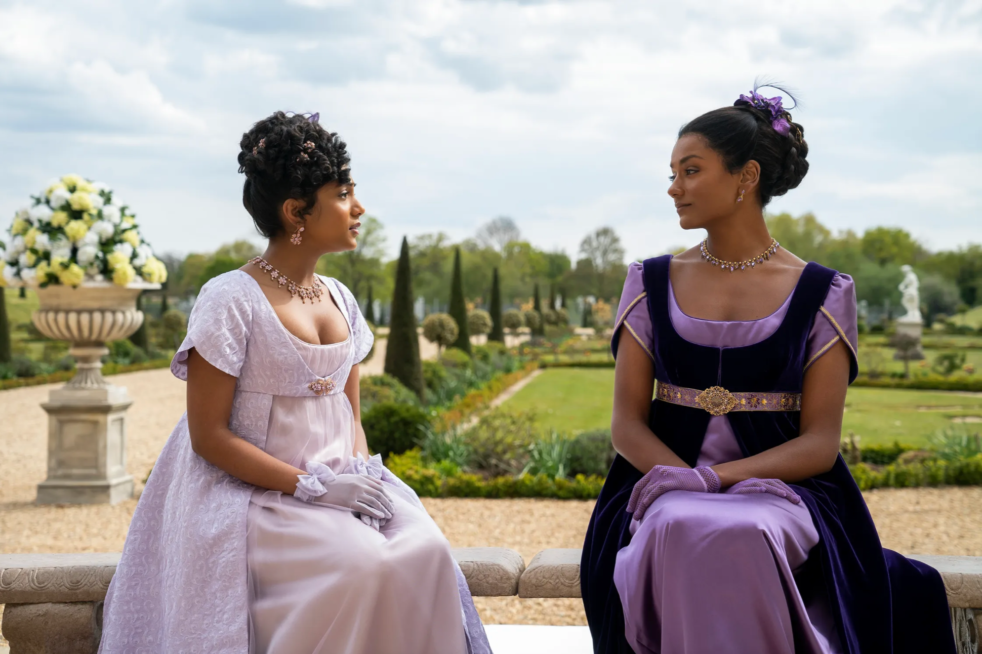After quickly rising through the ranks of Netflix’s most-watched series over the 2020 holiday season, “Bridgerton” cemented itself into the eyes of pop culture. The series found its place among the period pieces that have been gaining more widespread popularity, alongside the “Enola Holmes” movies and the “Anne with an E” reboot. In conjunction with the rise of these period pieces into more widespread popularity, similar growth in interest has been seen in the world of fashion history, as apparent on Youtube channels such as Bernadette Banner and Morgan Donner.
One of the early criticisms of the costumes in “Bridgerton,” particularly in the first season as the series was solidifying its identity, was how far the costumes veered away from the world of historical accuracy. Though the silhouette of the costumes, in particular the women’s gowns, were accurate to primary sources (such as fashion plates and paintings) from the Regency period, the fabrics and embellishments used were distinctly modern. While at first, this may appear to simply be a design choice to appeal more to modern audiences, the wardrobe of Bridgerton serves as a critical piece of its worldbuilding.
The characters of “Bridgerton” appear to be following distinct fashion rules and trends established throughout the show. There are clear delineations of what different people in different social classes are expected to wear during different social situations in order to meet societal expectations and norms. The noble families’ maids, for example, abide by their employers’ dress codes, (in particular, dressing in the family color), but all have similar dress styles consisting of simple, long-sleeved silk dresses.
The young, unmarried ladies in the show have the widest variety of situations they are shown dressed for. In the privacy of their homes, elegant loungewear in the form of house robes are shown to be the preferred style. During the day, their dresses are shown to be expensive silks or velvets, but not as extensively embellished as their ball gowns. The ballgowns and other evening wear donned by the young women of the show are elaborately decorated, featuring embroidery, sparkling gems and copious matching accessories.
While the textiles that make up these dresses, in particular the eveningwear, are not accurate to the show’s declared time period, there is a clear continuity within the show of what is considered fashionable. The young ladies of the show consistently wear delicate pastels with delicate feminine trimmings, and this rule is only broken to display a particular character’s misunderstanding of the social scene.
Characters and their families display distinct style preferences of their own that help serve as characterization. The most iconic example of this would be the Featherington family and their eccentric citrus color palette, which contrasts starkly with the pastels and jewel tones that are most popular with the young married ladies of the show. Within the world of “Bridgerton,” this color palette serves to display the family’s awkward attempts to conform to their society’s expectations.
On the other hand, the wealthy and beautiful Bridgerton family is characterized by a color palette of pale blues. The stunningly elegant gowns worn by the ladies of the Bridgerton household in the consistent palette show the stability of the Bridgertons’ status in society and the way that this status is somewhat effortless for them, just as they look effortlessly beautiful and fit into the crowd perfectly in their dresses.
The level at which a dress is decorated serves to show the wealth of the girl’s family. When a lady’s dress is deemed to be “in poor taste” due to overdecoration, it shows her family’s lack of understanding of such delicate and unwritten rules of society.
The second season of “Bridgerton” solidified the worldbuilding that the show’s wardrobe worked to create. The season focuses on two new arrivals to London’s social scene, Kate and Edwina Sharma. Edwina, being the more delicate and traditionally desirable of the two, is dressed in feminine pastels throughout the entire show. Meanwhile, the more headstrong Kate is dressed in a darker palette more reminiscent of the married ladies in the show, a nod to her age being higher than the average lady in search of a husband in the show.
“Bridgerton” serves as a shining example of the way in which period pieces can take an understanding of the history of fashions that are known to have existed within the time the piece is set, and put a modern spin on costuming without completely throwing away the feeling of believability.
